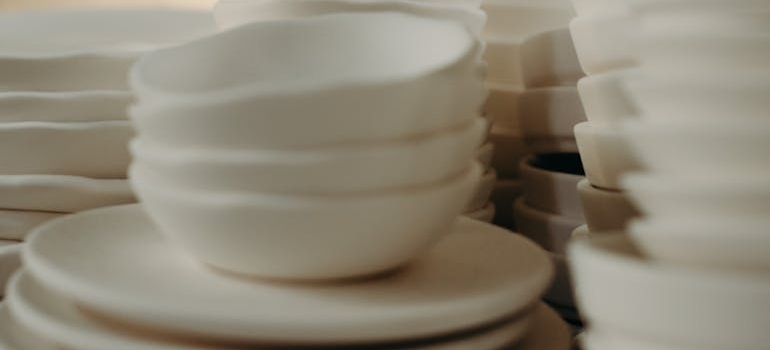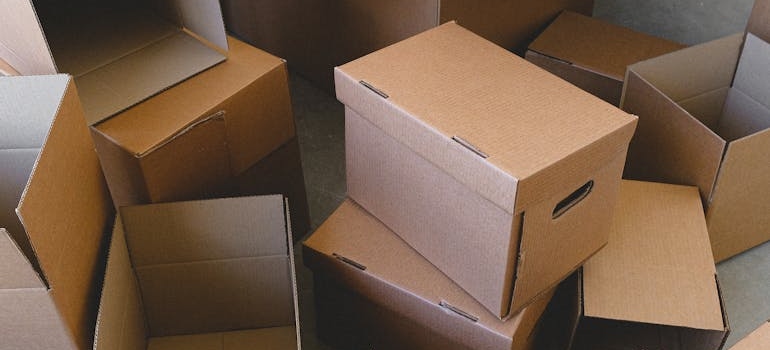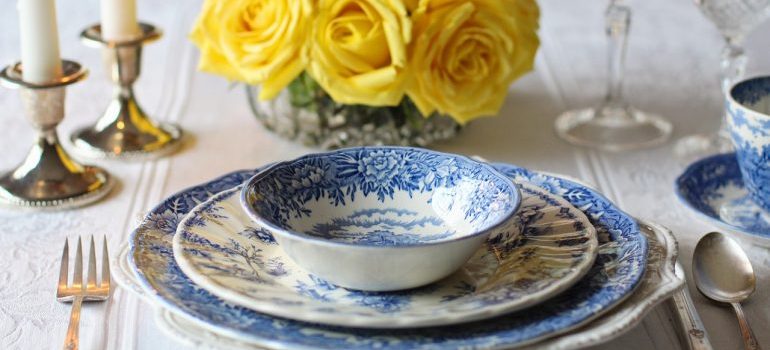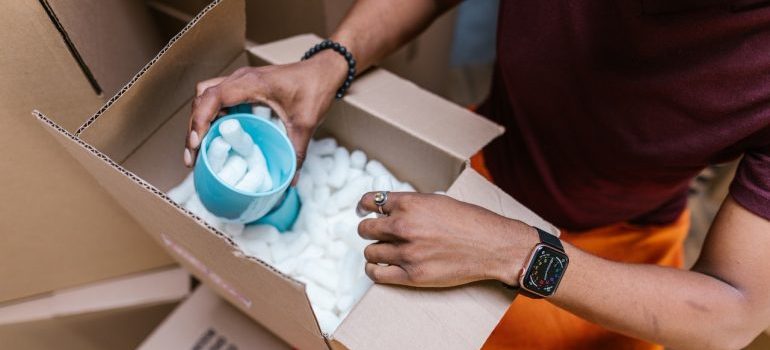Tips for Properly Packing and Moving Fine China
Fine china often holds sentimental and financial value, requiring extra care during a move. Proper packing and handling techniques minimize risks and ensure your cherished items arrive safely. This guide by the best movers in Boise offers detailed steps and professional advice for preparing, packing and moving fine china effectively.
Preparing to Pack Fine China
Preparation is the foundation of a safe and efficient packing process. Before handling your fine china, follow these key steps to organize and gather the necessary tools.
Inspect and Document Your Collection
Start by inspecting your fine china for any pre-existing damage. Look for cracks, chips, or weak areas like delicate handles or thin rims. Noting these vulnerabilities will help you prioritize which items need extra care during packing.
Also, create an inventory of your collection to stay organized. Document details such as the number of pieces, patterns, and current condition. Use photos to supplement written descriptions. This inventory can help unpack and serves as a record for insurance purposes.
Gather the Right Materials
Using the correct materials is essential for protection while packing and moving fine china. High-quality supplies will minimize the risk of damage during transport. Here’s a checklist of what you’ll need:
- Bubble wrap: Ideal for cushioning delicate items.
- Acid-free packing paper: Prevents scratches and keeps patterns intact.
- Sturdy boxes: Choose durable, double-walled boxes for extra protection.
- Foam sheets: Add padding between items.
- Dividers or dish-packing kits: Keeps plates and bowls separated.
- Packing tape: Secures wrapping and boxes effectively.
- Cushioning materials: Foam peanuts or crumpled paper fill empty spaces.
Avoid using newspapers, as the ink can transfer onto your china and cause permanent stains. Dish-packing kits are particularly useful for organizing plates and bowls, making the packing process more efficient.
Steps to Pack Plates, Bowls, and Platters
Packing plates, bowls, and platters correctly is crucial to prevent chipping and cracking. Each item requires individual attention and secure placement within the box.
Wrap Each Piece Individually
Start by laying out a sheet of bubble wrap or packing paper on a flat surface. Place the item in the center and fold the material over the edges, covering the entire surface. Wrap the item tightly but gently, ensuring that no areas are left exposed. Use packing tape to secure the wrapping. Avoid taping directly onto the china, as this can damage delicate patterns or finishes. Proper wrapping is the first line of defense against scratches and impacts.
Add a Cushioning Base to the Box
Before placing items inside the box, create a cushioning layer at the bottom. Use crumpled paper, foam sheets, or bubble wrap to build a thick base. This padding absorbs shocks and helps protect your china from external impacts during the move.
Position Plates Vertically
Instead of stacking plates flat, position them vertically in the box. This reduces pressure on the center of each plate, which is where cracks often start. Use dividers or foam sheets to separate each plate, ensuring they don’t touch. For bowls, nest them together only if they are of similar size and shape. Wrap each bowl individually before stacking them. Add padding between layers to prevent movement.
Fill Gaps to Prevent Shifting
Movement inside the box is a leading cause of damage during transport. After placing items in the box, fill all empty spaces with foam peanuts or crumpled paper. This stabilizes the contents and minimizes the risk of shifting during the move.

Packing Delicate Cups, Saucers, and Glassware
Cups, saucers, and glassware require additional care due to their unique shapes and fragile parts. Focus on protecting vulnerable areas, like handles and thin edges, to ensure their safety.
Add Layers of Padding
Line the bottom of the box with cushioning packing supplies in Boise before placing any items inside. Once the items are packed, fill any gaps with foam peanuts or crumpled paper. A snug fit reduces movement and provides extra stability.
Protect Handles and Fragile Edges
Wrap handles, stems, or thin rims separately before wrapping the entire piece. Use small pieces of bubble wrap or foam for added protection. Once these areas are secure, wrap the entire item in packing paper or bubble wrap, covering all surfaces.
Use Smaller Boxes
Smaller boxes are ideal for cups, saucers, and glassware, as they reduce the risk of overpacking. Overloaded boxes can become too heavy to handle and increase the chance of breakage. Smaller boxes also make it easier to distribute weight evenly across multiple packages.
Utilize Dividers for Separation
Dividers, either store-bought or homemade from cardboard, keep items from touching. Place each cup, saucer, or glass in its own section to prevent them from bumping into one another. If dividers aren’t available, wrap each item individually and use padding to separate them.
Labeling and Organizing Boxes
Proper labeling and organization are crucial for protecting your fine china during the move. Clearly marked boxes and a systematic approach help ensure everything is carried with care.
Categorize by Item Type
Group similar items together for easier unpacking. For example, keep plates and bowls in one box and cups and glassware in another. Label each box with a brief description of its contents, such as “China – Dinner Plates.” Avoid overly detailed labels to maintain privacy during the move.
Use Bold, Clear Labels
Mark each box as “Fragile” in large, bold letters on all sides. Use additional labels like “Handle with Care” and “This Side Up” to provide clear instructions for your local movers in Boise. Bright-colored stickers or tape can make the boxes stand out further, reducing the chances of mishandling.
Number Your Boxes
Numbering boxes adds another layer of organization. If you’re keeping an inventory, assign each box a number and reference it in your list. This system helps you quickly locate specific items and ensures nothing gets lost.

Loading and Transporting Fine China
Packing and moving fine china carefully is only part of the process. How you load the boxes into the vehicle and handle them during transportation is equally important. Even well-packed china can sustain damage if placed incorrectly or subjected to unnecessary movement.
Position Boxes Strategically
Fine china boxes should be placed on top of sturdier, heavier boxes. Avoid stacking anything heavy on top of these fragile items, as the weight could crush or damage the contents. Always load the boxes upright, especially those containing plates, bowls, or glassware. Their vertical position minimizes the chances of cracking or breaking under pressure.
If possible, designate a specific section of the moving truck or vehicle for fragile items. Placing all delicate boxes together makes it easier to monitor and protect them. Use moving straps or ropes to secure these boxes and prevent them from shifting during transit.
Cushion Boxes in the Truck
Even if the china is securely packed, additional cushioning around the boxes adds an extra layer of protection. Use blankets, towels, or foam pads to line the area where the boxes will be placed. This protects them from external impacts caused by sudden stops or bumpy roads. If you’re moving in your car, consider placing the boxes on the backseat rather than the trunk for better shock absorption.
Avoid Extreme Temperatures
Fine china can be sensitive to temperature changes, especially if it contains gold or silver accents. Extreme heat or cold can cause these decorations to crack, tarnish, or discolor. Keep the boxes away from direct sunlight or areas in the truck that are exposed to external temperatures. If you’re moving with long distance movers in Idaho, check the weather and plan accordingly to minimize exposure to harsh conditions.
Tips for Unpacking Fine China Safely
Unpacking fine china requires the same level of care as packing. Rushing through this stage can undo all the effort you’ve put into ensuring its safety. A thoughtful, step-by-step approach reduces the risk of accidental damage and makes organizing easier.
Prepare a Workspace
Before opening any boxes, set up a clean, cushioned workspace to unpack your china. Use a sturdy table covered with soft padding, such as a thick towel, foam sheet, or blanket. This provides a safe surface for placing delicate items as you unpack. Ensure the area is free of clutter to avoid any unnecessary mishaps.
Unpack One Box at a Time
Begin with the boxes labeled as “Fragile” or those containing larger, sturdier pieces. Open each box carefully, cutting the tape gently to avoid damaging the contents. Remove the padding layer by layer, taking care not to jostle the items inside. Unwrap each piece individually, inspecting it for damage as you go. Taking your time during this process prevents mistakes.

Check Against Your Inventory
As you unpack, refer to your inventory list to ensure all items are accounted for and in good condition. If any pieces are missing or damaged, document the issue with photos and notes. If you’ve purchased insurance, this documentation will be necessary for filing a claim.
Organize Thoughtfully
Once the fine china is unpacked, decide on its placement in your new home. Use padded liners for shelves or cabinets to prevent scratching. Keep heavier items on lower shelves and lighter, more fragile items higher up to reduce the risk of accidents. Arrange the pieces in a way that balances accessibility with safety.
Additional Precautions
Moving fine china successfully often involves taking extra precautions. These small yet impactful steps add additional layers of protection and peace of mind.
Consider Professional Movers
If packing and moving fine china feels overwhelming, consider booking professional moving services in Boise ID specializing in handling delicate items. Many moving companies offer services specifically tailored to fragile belongings, such as custom crating and careful handling. Research companies thoroughly to ensure they have experience with fine china.
Use a “Fragile First” Policy
During loading and unloading, make it a priority to handle fragile boxes first. Ensuring they’re placed in a safe location upon arrival minimizes the risk of accidental damage. Keeping these items at the forefront of your moving plan emphasizes their importance to everyone involved in the process.
Purchase Insurance
Moving insurance is a worthwhile investment when transporting valuable or irreplaceable items. Check your existing homeowner’s or renter’s policy to see if it covers damage during a move. If not, look into supplemental moving insurance that specifically covers fragile or high-value items like fine china. Be sure to read the policy details carefully to understand what is covered and how claims are processed.
Common Mistakes to Avoid
Avoiding common pitfalls can save you time, money, and frustration. Being aware of these mistakes ensures a smoother moving experience and better protection for your fine china.
Skipping Padding
One of the most frequent mistakes is underestimating the importance of padding. Thin or inadequate cushioning materials can fail to absorb shocks during transit, leaving your items vulnerable to damage. Always use high-quality materials like bubble wrap and foam sheets to provide sufficient protection.

Overpacking Boxes
Packing too many items into a single box increases the likelihood of breakage. Overloaded boxes can become too heavy to lift safely and are more likely to collapse under their own weight. Limit the number of items in each box and distribute the weight evenly across multiple containers.
Rushing Through the Process
Haste often leads to mistakes. Skipping steps, ignoring precautions, or failing to double-check your work can result in unnecessary risks. Allocate enough time for each stage of the packing, moving, and unpacking process to avoid errors.
Using Substandard Materials
Old or weak boxes, low-quality tape, and cheap padding materials are unreliable and can lead to preventable damage. Invest in durable moving boxes in Boise and strong packing tape to ensure your items stay secure throughout the move.
Protecting Memories, One Piece at a Time
Packing and moving fine china is a meticulous process, but with the right approach, it can be done safely and efficiently. Preparing your collection, using high-quality materials, and following proper techniques for packing, loading, and unpacking all contribute to protecting your cherished items. Avoiding common mistakes and taking additional precautions, such as hiring professionals or purchasing insurance, adds extra layers of security. But if you handle each step with care and patience, you can ensure your fine china arrives intact and ready to bring elegance to your new home.

